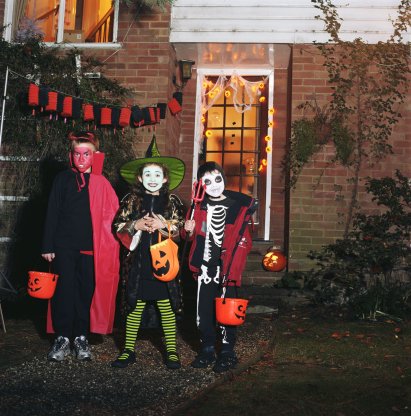
Halloween is an annual holiday celebrated on 31st October. The historian Nicholas Rogers, exploring the origins of Halloween, has discovered that its origin is Celtic. The ancient Celts thought that the line that joins this world with "another world" was bigger with the arrival of the Samhain (a similar party). The harmful spirits are removed. It is believed that sweets and masks are used to banish the malignant spirits. In Scotland the spirits were supplanted by young men with white masks. The word Halloween means: All Hallows Day.
The harmful spirits are removed. It is believed that sweets and masks are used to banish the malignant spirits. In Scotland the spirits were supplanted by young men with white masks. The word Halloween means: All Hallows Day.
There are different ways of representing this party: the pumpkins, the candles... Halloween imagery includes themes of death, evil, the occult, magic, mythical monsters, ghosts, witches, skeletons, vampires, werewolves, demons, bats, and black cats. Black and orange represent the darkness of night and the color of bonfires, autumn leaves, and jack-o'-lanterns.
Children go to houses asking for sweets. The typical phrase is: trick or treat. Halloween costumes are traditionally modeled after monsters such as ghosts, skeletons, witches, and devils. Over time, the costume selection extended to include popular characters from fiction, celebrities, and generic archetypes such as ninjas and princesses. Dressing up was prevalent in Scotland and Ireland at Halloween by the 19th century. Costumes became popular for Halloween parties in the US in the 20th century, for adults as well as for children.
The first mass-produced Halloween costumes appeared in stores in the 1930s in the United States.There are also costumes of pop culture, like presidents, athletes, celebrities, or film, television, and cartoon characters. Another popular trend is for women (and in some cases, men) to use Halloween as an excuse to wear sexy or revealing costumes, showing off more skin than would be socially acceptable otherwise. There are several games traditionally associated with Halloween. One common game is dunking or apple bobbing, in which apples float in a tub or a large basin of water and the participants must use their teeth to remove an apple from the basin. Another common game involves hanging up treacle or syrup-coated scones by strings; these must be eaten without using hands while they remain attached to the string.
Halloween is not celebrated in all the countries and regions of the world. Celebrations in the United States and Canada have had a significant impact on how the holiday is observed in other nations. In my city, Málaga, I meet my friends and we celebrate a party with many sweets. We do many games too. Our favorite game is after turning off the lights, we hide and a person must find us. It's called The Black Hall.
Angel Luís Díez López, 3º ESO B
Halloween is a very famous party in UK, but in Málaga too. Here, children go to the houses to ask for sweets, and some people give them money.
Children dress up and make-up to be scarier than their friends. Children dress up as vampires , witches , Frankestein and as ghosts.
The English people that live in Málaga give a lot of money and many sweets to the children because they remember their cities.
The typical colours are orange, black and red. Some people buy pumpkins to decorate their homes.
Carmen María Méndez Moreno 3º ESO B
Halloween will be here soon!
This typical English and American celebration is very popular in the world. Halloween is a very ancient celebration in honour of the dead.
People feast it in UK, and America of course, but in other countries too, like, for example, in Spain, concretely in Málaga, the city where I live.
In Málaga, teenagers and kids go out with their friends at night. Usually, kids disguise like monsters, ghosts, witches, sick-people, dead-men and dead-women , Frankenstein, the dead bride… and then, they go to their neighbours' houses to request candies and lollipops with the typical sentence “trick or treat” (like the English and American kids do).
Teenagers don´t always do the same; some of them make parties at friends' houses , or they meet and tell stories of fear, or they impersonate kids… some of them don´t celebrate it.
Another thing that they do for Halloween is to scare friends with all kinds of jokes .
Finally: don´t stay at home in Halloween!
Candela Mesa Cuevas 3º ESO B











